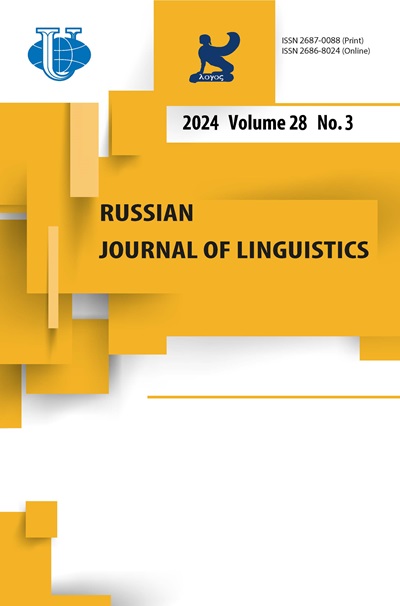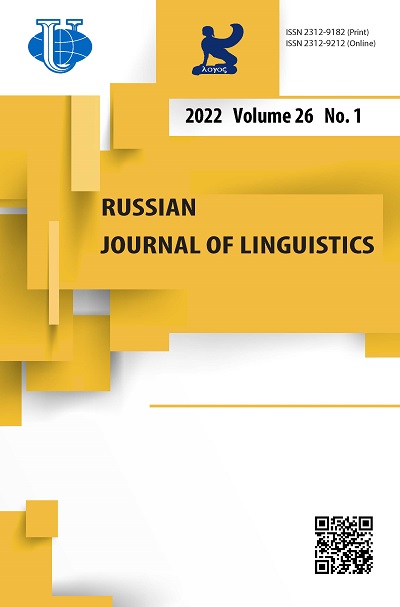Филогенетические деревья: грамматика против словаря
- Авторы: Поляков В.Н1, Макарова Е.А.2, Соловьев В.Д.3
-
Учреждения:
- Институт языкознания РАН
- Казанский федеральный университет
- Выпуск: Том 26, № 1 (2022)
- Страницы: 31-50
- Раздел: Статьи
- URL: https://journals.rudn.ru/linguistics/article/view/30639
- DOI: https://doi.org/10.22363/2687-0088-26460
Цитировать
Полный текст
Аннотация
Традиционно генеалогические отношения между языками устанавливаются на основе фонетических и лексических данных. Вопрос о том, можно ли определить генеалогические отношения между языками на основе грамматических данных, остается без ответа. Цель этой статьи - сравнить два филогенетических дерева: одно построено с использованием проекта Автоматизированной программы оценки сходства (ASJP), а другое - с использованием Всемирного атласа языковых структур (WALS). Мы включаем данные из WALS, представляющие 27 языков из 5 языковых семей всех континентов, которые достаточно хорошо описаны. Для всех исследуемых языков была рассчитана матрица расстояний Хэмминга и на ее основе построено филогенетическое дерево. Деревья, построенные по данным WALS и ASJP сравниваются между собой и с деревом, созданном с опорой на классический сравнительно-исторический метод. И у дерева на основе ASJP, и у дерева но основе WALS есть свои преимущества и недостатки. Дерево на основе ASJP указывает на расхождение языков в процессе эволюции. Сходство языков, рассчитанное на основе типологической базы данных WALS, может предоставить информацию об истории языков как с точки зрения генеалогического происхождения, так и с точки зрения контакта с другими языками. Дерево на основе ASJP хорошо отражает генеалогическое родство на относительно небольшой временной глубине, а дерево на основе WALS - на больших временных интервалах. Мы предлагаем новый вариант филогенетического дерева, который включает информацию как о дивергенции (проект ASJP), так и о конвергенции (проект WALS) языков, объединяя преимущества обоих этих деревьев, хотя при этом остается проблема учета заимствований. В настоящей работе обозначены перспективы будущих исследований генеалогических отношений между языками на основе крупномасштабных описаний их грамматических структур.
Об авторах
В. Н Поляков
Автор, ответственный за переписку.
Email: MakarovaEA@iling-ran.ru
Елена Андреевна Макарова
Институт языкознания РАН
Email: MakarovaEA@iling-ran.ru
младший научный сотрудник сектора прикладного языкознания Россия, Москва, 125009, Б. Кисловский пер. д. 1 стр. 1
Валерий Дмитриевич Соловьев
Казанский федеральный университет
Email: maki.solovyev@mail.ru
доктор физико-математических наук, профессор, главный научный сотрудник НИЛ «Текстовая аналитика» Россия, 420008, г. Казань, ул. Кремлевская, 18
Список литературы
- Anisimov, Ivan, Vladimir N. Polyakov & Valery D. Solovyev. 2013. Database “Languages of the World.” New Version. New Research Horizons. In Svetlana Masalóva & Valery Solovyev (eds.), Proceedings of the First International Forum on Cognitive Modeling 14-21 September, 2013, Italy, Milano Marittima. Part 1. Cognitive modeling in linguistics: Proceedings of the XIV International Conference “Cognitive Modeling in Linguistics. CML-2013,” 27-34. Rostov-on-Don: Southern Federal University Press
- Barbançon, François et al. 2013. An experimental study comparing linguistic phylogenetic reconstruction methods. Diachronica 30(2). 143-170. https://doi.org/10.1075/Dia.30.2.01bar
- Bech, Kristin & George Walkden. 2016. English is (still) a West Germanic language. Nordic Journal of Linguistics 39(1). 65-100. https://doi.org/10.1017/S0332586515000219
- Benveniste, Emile. 1954. La classification des langues. Conferences de l'Institut de Linguistique de l'Universite de Paris 11. 33-50.
- Birchall, Joshua, Michael Dunn & Simon J. Greenhill. 2016. A combined comparative and phylogenetic analysis of the Chapacuran language family. International Journal of American Linguistics 82(3). 255-284.
- Bopp, Franz. 1885. A Comparative Grammar of the Sanskrit, Zend, Greek, Latin, Lithuanian, Gothic, German, and Slavonic Languages; Volume 1. London: Williams.
- Brown, Cecil H. et al. 2008. Automated classification of the world's languages: A description of the method and preliminary results. STUF - Language Typology and Universals 61(4). 285-308.
- Burlak, Svetlana & Sergei Starostin. 2005. Sravnitel'no-istoricheskoe Yazykoznanie [Comparative Linguistics]. Moscow: Publishing center “Academia.”
- Chang, Will et al. 2015. Ancestry-constrained phylogenetic analysis supports the Indo-European steppe hypothesis. Language 91(2). 194-244.
- Coloma, Germán. 2017. Complexity trade-offs in the 100-language WALS sample. Language Sciences 59. 148-158. https://doi.org/10.1016/j.langsci.201 6.10.006
- Donohue, Mark & Simon Musgrave. 2007. Typology and the linguistic macro-history of island Melanesia. Oceanic Linguistics 46. 348-387.
- Donohue, Mark et al. 2011. Typological feature analysis models linguistic geography. Language 87(2). 369-383.
- Donohue, Mark et al. 2008. Typology, areality and diffusion. Oceanic Linguistics 47(1). 223-232.
- Dryer, Matthew S. & Martin Haspelmath (eds.). 2013. The World Atlas of Language Structures online. Leipzig: Max Planck Institute for Evolutionary Anthropology. http://wals.info (accessed 20 January 2018).
- Dunn, Michael. 2015. Language phylogenies. In Claire Bowern & Bethwyn Evans (eds.), The Routledge handbook of historical linguistics, 190-211. New York: Routledge.
- Dunn, Michael et al. 2007. Statistical reasoning in the evaluation of typological diversity in Island Melanesia. Oceanic Linguistics 46. 388-403.
- Dunn, Michael et al. 2008. Structural phylogeny in historical linguistics: Methodological explorations applied in Island Melanesia. Language 84(4). 710-759. https://doi.org/10.1353/lan.0.0069
- Dunn, Michael et al. 2005. Structural phylogenetics and the reconstruction of ancient language history. Science 309. 2072-2075.
- Edwards, Anthony, William Fairbank & Luigi Luca Cavalli-Sforza. 1964. Reconstruction of evolutionary trees. Phonetic and Phylogenetic Classification. Systematics Association Publication 6. 67-76. http://www.faculty.biol.ttu.edu/Strauss/Phylogenetics/Readings/EdwardsCavalliSforza1964.pdf (accessed 21 February 2018).
- Emonds, Joseph Embley & Jan Terje Faarlund. 2014. English: The language of the Vikings. Olomouc modern language monographs 3. Olomouc: Palacký University
- Felsenstein, Joseph. 2003. Inferring Phylogenies. Sunderland, MA: Sinauer Associates
- Gray, Russell D. & Quentin D. Atkinson. 2003. Language-tree divergence times support the Anatolian theory of Indo-European Origin. Nature 426(6965). 435-439. https://doi.org/10.1038/nature02029
- Gray, Russell D. & Fiona M. Jordan. 2000. Language trees support the express-train sequence of Austronesian expansion. Nature 405(6790). 1052-1055.
- Gray, Russell D., David Bryant & Simon J. Greenhill. 2010. On the shape and fabric of human history. Philosophical Transactions of the Royal Society B 365. 3923-3933.
- Hamming, Richard W. 1950. Error detecting and error correcting codes. Bell System Technical Journal 29(2). 147-160. https://doi.org/10.1002/j.1538-7305.1950.tb00463.x
- Haspelmath, Martin et al. 2005. The World Atlas of language structures. 1 st ed. Oxford: Oxford University Press.
- Holman, Eric W. & Søren Wichmann. 2017. New evidence from linguistic phylogenetics supports phyletic gradualism. Systematic Biology 66(4). 604-610. https://doi.org/10.1093/sysbio/syw106
- Holman, Eric W. et al. 2008. Explorations in automated language classification. Folia Linguistica 42(2). 331-354
- Hornung, Annette. 2017. English: The Grammar of the Danelaw. Arizona State University, ProQuest Dissertations Publishing
- Kolipakam, Vishnupriya et al. 2018. A Bayesian phylogenetic study of the Dravidian language family. Royal Society Open Science 5(3). https://doi.org/10.1098/rsos.171504
- Kumar, Sudhir, Glen Stecher & Koichiro Tamura. 2016. MEGA7: Molecular Evolutionary Genetics Analysis version 7.0 for bigger datasets. Molecular Biology and Evolution 33(7). 1870-1874. https://doi.org/10.1093/molbev/msw054
- Lewis, Paul M. (ed.). 2009. Ethnologue: Languages of the World (Sixteenth edition). Dallas, Texas: SIL International. http://www.ethnologue.com/ (accessed 20 January 2018)
- Longobardi, Giuseppe et al. 2015. Toward a syntactic phylogeny of modern Indo-European languages. In Leonid Kulikov & Nikolaos Lavidas (eds.), Proto-Indo-European syntax and its development, 125-156. Amsterdam: John Benjamins Publishing Company
- Lutz, Angelika. Norse loans in Middle English and their influence on Late Medieval London English. Anglia 135(2). 317-357. https://doi.org/10.1515/ang-2017-0028
- Maslov, Yu. 2005. Bolgarsky [Bulgarian]. In Languages of the World. Slavic languages. 69-102. Moscow: Academia
- Mattila, Heikki E. S. 2006. Legal language: History. In Keith Brown (ed.), Encyclopedia of language and linguistics (2nd ed.), 8-13. London: Elsevier. https://doi.org/10.1016/B0-08-044854-2/04504-1
- Müller, André et al. 2013. ASJP World Language Tree of Lexical Similarity: Version 4 (October 2013). http://asjp.clld.org/
- Nakleh, Luay, Don Ringe & Tandy Warnow. 2005. Perfect phylogenetic networks: A new methodology for reconstructing the evolutionary history of natural languages. Language 81(2). 382-420.
- Nichols, Johanna & Tandy Warnow. 2008. Tutorial on computational linguistic phylogeny. Language and Linguistics Compass 5(2). 760-820.
- Oransky, Iosif Mikhailovich. 1979. Iranian Languages in Historical Perspective. Moscow: Nauka. http://www.orientalstudies.ru/rus/index.php?option=com_publications&Itemid=75&pub=619 (accessed 20 March 2021).
- Pagel, M. & Meade, A. 2006. Bayesian analysis of correlated evolution of discrete characters by reversible-jump Markov chain Monte Carlo. American Naturalist 167. 808-825
- Polyakov, Vladimir N., Ivan S. Anisimov & Elena A. Makarova. 2016. Can grammar define similarity of human natural languages? American Journal of Applied Sciences 13(10). 1040-1052. https://doi.org/10.3844/ajassp.2016.1040.1052
- Polyakov, Vladimir N. et al. 2009. Using WALS and languages of the world. Linguistic Typology 13(1). 137-167. https://doi.org/10.1515/LITY.2009.008
- Pompei, Simone, Vittorio Loreto & Francesca Tria. 2011. On the accuracy of language trees. PLoS ONE 6(6). e20109. https://doi.org/10.1371/journal.pone.0020109
- Rama, Taraka & Lars Borin. 2015. Comparative evaluation of string similarity measures for automatic language classification. Sequences in language and text. http://spraakdata.gu.se/taraka/string-similarities-pdf2doc.pdf (accessed 13 April 2021).
- Ringe, Don, Tandy Warnow & Ann Taylor. 2002. Indo-European and computational cladistics. Transactions of the Philological Society 100(1). 59-129.
- Schrijver, Peter. 2014. Language Contact and the Origins of the Germanic Languages. New York: Routledge.
- Seebold, Elmar S. 2006. Westgermanische Sprachen [West Germanic Languages], Reallexikon der germanischen Altertumskunde 33. 530-536.
- Solovyev, Valery. 2009. Is grammochronology possible? Proceedings of the Swadesh Centenary Conference, 17-18 January 2009. Munich: Official Website of Max Planck Institute for Evolutionary Anthropology. http://www.eva.mpg.de/lingua/conference/09_SwadeshCentenary/pdf/abstracts/Valery_Solovyev.pdf (accessed 15 April 2021).
- Swadesh, Morris. 1950. Salish internal relationships. International Journal of American Linguistics 16. 157-167.
- Swadesh, Morris. 1952. Lexicostatistic dating of prehistoric ethnic contacts. Proceedings of the American Philosophical Society 96. 452-463.
- Swadesh, Morris. 1955. Towards greater accuracy in lexicostatistic dating. International Journal of American Linguistics 21. 121-137. https://lib.ugent.be/catalog/rug01:002194436 (accessed 5 May 2021).
- Trubetzkoy, Nikolai S. 1939. Gedanken über das Indogermanenproblem [Commemoration of the Indo-Germanic problem]. Acta Linguistica. Copenhague 1(1). 81-89. https://doi.org/10.1080/03740463.1939.10410851
- Wichmann, Søren. 2013. A classification of Papuan languages. In: Hammarström, Harald and Wilco van den Heuvel (eds.), History, contact and classification of Papuan languages (Language and Linguistics in Melanesia, Special Issue 2012), 313-386. Port Moresby: Linguistic Society of Papua New Guinea
- Wichmann, Søren. 2017a. Genealogical classification in historical linguistics. In Mark Aronoff (ed.), Oxford research encyclopedias: Linguistics. Oxford: Oxford University Press. https://doi.org/10.1093/acrefore/9780199384655.013.78
- Wichmann, Søren. 2017b. Modeling language family expansions. Diachronica 34(1). 79-101. https://doi.org/10.1075/dia.34.1.03wic
- Wichmann, Søren & Eric W. Holman. 2010b. Pairwise comparisons of typological profiles. In Jan Wohlgemuth & Michael Cysouw (eds.), Rethinking universals: How rarities affect linguistic theory, 241-254. Berlin/New York: Walter de Gruyter Publishers. https://doi.org/10.1.1.558.3743&rep=rep1&type=pdf
- Wichmann, Søren & Jeff Good. 2014. Introduction. In Søren Wichmann & Jeff Good (eds.), Quantifying language dynamics: On the cutting edge of areal and phylogenetic linguistics, 1-6. Leiden: Brill.
- Wichmann, Søren & Eric W. Holman. 2009. Temporal Stability of Linguistic Typological Features. München: LINCOM Europa.
- Wichmann, Søren et al. 2010b. Evaluating linguistic distance measures. Physica A 389. 3632-3639. https://doi.org/10.1016/j.physa. 2010.05.011
- Wichmann, Søren, Eric W. Holman & Cecil H. Brown (eds.). 2016. The ASJP Database (version 17). Available at: http://asjp.clld.org/ (Accessed 4 February 2018).
- Wichmann, Søren, André Müller & Viveka Velupillai. 2010a. Homelands of the world’s language families: A quantitative approach. Diachronica 27(2). 247-276.
- Wichmann, Søren & Taraka Rama. 2018. Jackknifing the black sheep: ASJP classification performance and Austronesian. In Kikusawa, Ritsuko and Lawrence A. Reid (eds.), Let’s talk about Trees: Genetic relationships of languages and their phylogenic representation, 39-58. Senri Ethnological Studies 98. Osaka: National Museum of Ethnology, Japan
- Wichmann, Søren & Arpiar Saunders. 2007. How to use typological databases in historical linguistic research. Diachronica 24.2. 373-404.
- Wong, Kok-Seng & Myung Ho Kim. 2014. On private Hamming distance computation. The Journal of Supercomputing 69(3). 1123-1138. https://doi.org/10.1007/s11227-013-1063-z

















